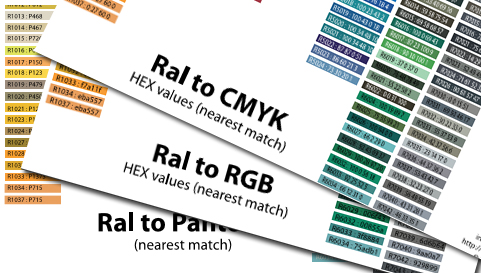
The conversion used is IEC 61966:2-1 D50 adapted which may differ from other conversions.These comparisons should therefore be taken as a guide only. However, if selection is from a scanned or digital photograph on the screen, please also be aware that RGB values can also be affected by lighting, sunlight, shade, camera settings and the scanning or editing application/software used. If selecting the RGB values from a website, you can use the colour picker in Firefox or Google Chrome browsers. In addition, colours can appear different depending on the type of monitor and the progamme/software application. RGB values or representations can vary by programme, application and age of the screen or the computer. Please note that RGB and sRGB are methods to represent colours on a screen/monitor and cannot necessarily be reproduced in paint or printed ink colours.
#Ral to rgb color conversion software
RAL Digital is software that allows designers to navigate the RAL colour space.Convert RGB values to the nearest standard colour It is the first collection from RAL to be based on waterborne paint systems. RAL Effect comprises 420 solid colours and seventy metallic colours. Conversion from RAL Design number tuple to CIELAB RAL Design = ( h a b ∘, L ∗, C a b ∗ ) a ∗ = C a b ∗ ⋅ cos ( h a b ∘ ) b ∗ = C a b ∗ ⋅ sin ( h a b ∘ ) "RAL 210 50 15" converts to L* = 50, a* = −12.99, b* = −7.5, for instance. The three numeric components of almost all RAL Design colours are multiples of 5, the majority are divisible by 10. Each colour is represented by seven digits, grouped in a triple and two pairs, representing hue (000–360 degrees, angle in the CIELab colour wheel), lightness (same as in L* a* b*) and chroma (relative saturation). The colours of RAL Classic and RAL Design do not intersect.Ĭontrary to the preceding systems, RAL Design features no names and its numbering follows a scheme based on the CIELAB color space, specifically cylindrical CIEHLC.

It started with 1,688 colours and was revised to 1,625 colours and now 1825 colours. In 1993, a new colour matching system was introduced, tailored to the needs of architects, designers and advertisers. It is now made up of ten colours (RAL 1039-F9 Sand beige, RAL 1040-F9 Clay beige, RAL 6031-F9 Bronze green, RAL 6040-F9-Light olive, RAL 7050-F9 Camouflage grey, RAL 8027-F9 Leather brown, RAL 8031-F9 Sand brown, RAL 9021-F9 Tar black and RAL 6031-HR Bronze green for non-camouflage applications), used by the Bundeswehr for military camouflage coating. This collection, which follows the naming of RAL Classic, was invented in 1984. The first digit relates to the shade of the colour: Therefore, most of the colours in it are used on warning and traffic signs or are dedicated to government agencies and public services (for example: RAL 1004 - Swiss Postal Service, RAL 1021 - Austrian Postal Service, RAL 1032 - German Postal Service). A main criterion for colours in the RAL Classic collection is to be of "paramount interest". Īs "RAL 840-HR" covered only matte paint the 1980s saw the invention of "RAL 841-GL" for glossy surfaces, limited to 193 colours.

At the international furnishing fair imm Cologne, 13 till 19 January 2020, two new colours were presented in the Classic Collection: RAL 2017 RAL Orange and RAL 9012 Clean Room White. In the 1960s the colours were given supplemental names to avoid confusion in case of transposed digits. With tints constantly added to the collection, it was revised again in 1961 and changed to "RAL 840-HR", which consists of 210 colours and is in use to this day. Army camouflage colors were always recognized by a "7" or "8" in the first place until 1944. In the 1930s the numbers were changed uniformly to four digits and the collection was renamed to "RAL 840 R" (R for revised).Īround 1940 the RAL colors were changed to the four-digit system, as is customary. Prior to that date manufacturers and customers had to exchange samples to describe a tint, whereas from then on they would rely on numbers. In 1927, the German group Reichs-Ausschuß für Lieferbedingungen (Imperial Committee for Delivery and Quality Assurance) invented a collection of forty colours under the name of "RAL 840". See also: List of RAL colors RAL Classic


 0 kommentar(er)
0 kommentar(er)
